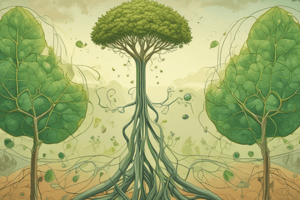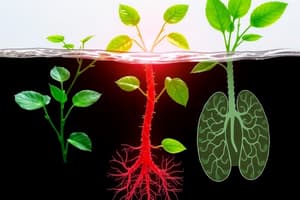Podcast
Questions and Answers
What do autotrophs obtain through self-manufacture?
What do autotrophs obtain through self-manufacture?
What is the primary function of roots in a plant?
What is the primary function of roots in a plant?
What do heterotrophs rely on for carbon, nitrogen, and phosphorus?
What do heterotrophs rely on for carbon, nitrogen, and phosphorus?
What is the primary function of the stem in a plant?
What is the primary function of the stem in a plant?
Signup and view all the answers
What is the primary function of leaves in a plant?
What is the primary function of leaves in a plant?
Signup and view all the answers
What do plants use glucose for?
What do plants use glucose for?
Signup and view all the answers
How do plants exchange gases?
How do plants exchange gases?
Signup and view all the answers
What regulates the opening and closing of stomata?
What regulates the opening and closing of stomata?
Signup and view all the answers
What is the primary function of the shoot system?
What is the primary function of the shoot system?
Signup and view all the answers
What is the primary function of alveoli in mammals?
What is the primary function of alveoli in mammals?
Signup and view all the answers
Study Notes
Autotrophs and Heterotrophs
- Autotrophs produce their own food through self-manufacture, while heterotrophs obtain organic nutrients by consuming autotrophs or other heterotrophs.
- Autotrophs are organisms that can prepare their own food, whereas heterotrophs depend on autotrophs and other organisms for nutrition.
Photosynthesis
- Autotrophs use energy from the sun to convert water and carbon dioxide into glucose, a type of sugar.
- Glucose provides energy for plants and is used to make cellulose, a substance for growth and cell wall development.
Plant Structure and Function
- Roots anchor the plant, transport water, minerals, and sugars, and store excess nutrients.
- Stems function in support, conduction, photosynthesis, and storage.
- Leaves are adapted for photosynthesis.
Gas Exchange
- Plants exchange gases through tiny pores called stomata, primarily located on the underside of leaves.
- Stomata are surrounded by guard cells, which regulate their opening and closing.
- In animals, gas exchange occurs through specialized respiratory organs like lungs, gills, or skin.
- Carbon dioxide is released into the atmosphere when fuels are burned.
Cellular Respiration
- Cells in both plants and animals perform respiration.
- Oxygen and carbon dioxide move through diffusion into the moist membrane.
- In simple animals, gas exchange occurs mainly with the environment.
- In complex animals, like mammals, there is an exchange between the environment and blood.
Studying That Suits You
Use AI to generate personalized quizzes and flashcards to suit your learning preferences.
Description
Learn the difference between autotrophs and heterotrophs, including how they obtain energy and nutrients. Discover the process of photosynthesis and its importance for autotrophs.




